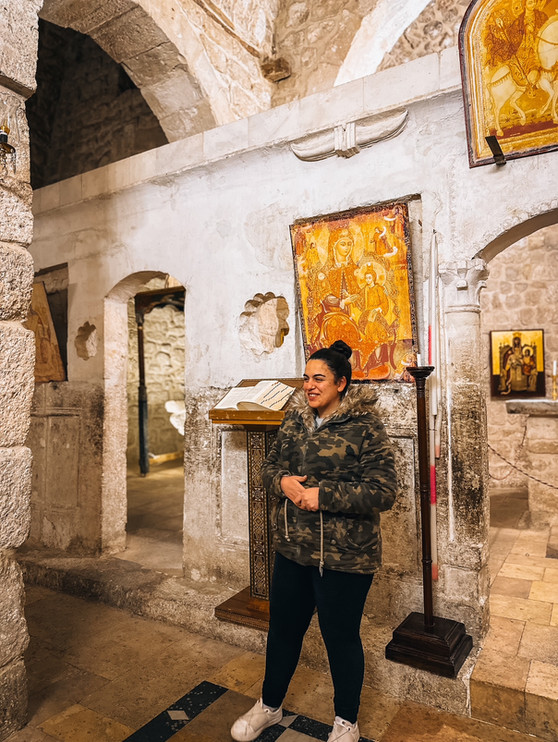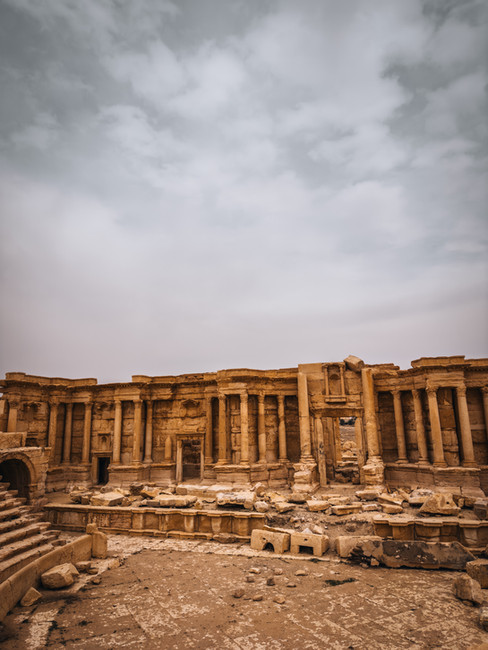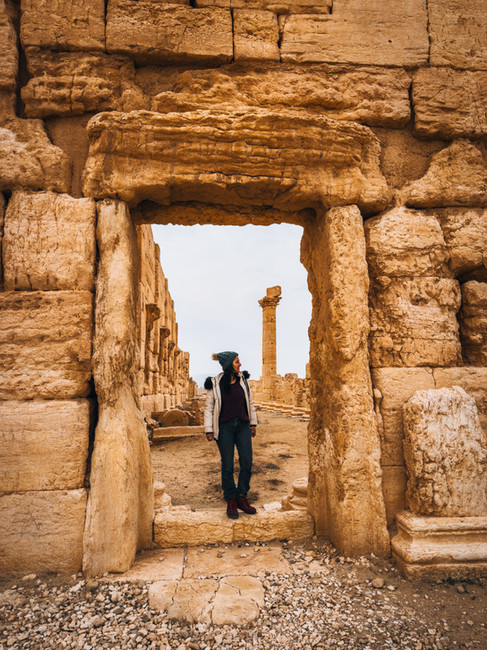The Ultimate Solo Traveler's Guide to Exploring Syria Safely
- Ankitha
- Mar 13, 2024
- 8 min read
Updated: May 23, 2024
A country that is the very heart of civilization - think the longest-inhabited cities, the first musical note, the first alphabet. This solo trip is right up there with Afghanistan as one of the most difficult and emotionally challenging destinations I have visited to date. The destruction is everywhere… unlike anything I have ever seen. That said, contrary to what is shared in the media, Syria is more than its past, more than collapsed buildings and rubble blocks.

Would you expect a warm welcome? Would you expect to be embraced? You should… if you visit, you will get exactly that, time and time again, over and over, until it’s almost overwhelming. Everyone wants to say hello. Everyone wants to make sure you’re having a good time. They’re surprised any traveler would take a punt on their country, that they’d come to see if the reality matches the headlines. It’s a nation of overwhelmingly decent people who just want to live their lives in peace and with dignity.
This travel guide to syria is a way for you to explore the country safely, alone or with a small group. Planning a trip to Syria doesn't have to be complicated - you just have to exert common sense and keep an open mind.
THINGS TO DO IN SYRIA
Land in Beirut, cross the border to Syria
Drive to Maaloula
Drive to Krak De Chevaliers
Drive to Hama
Drive to Allepo, stay two nights
Drive to Palmyra
Drive back to Damascus
Back to Beirut, Lebanon
TABLE OF CONTENTS
FLIGHTS + VISA
The best and most reliable way to get to Syria is through Lebanon. So fly into Beirut and then cross the border by road.
Irrespective of what passport you hold, you will need to have a security clearance to visit Syria. This process can take anywhere from four to six weeks. You can enter the country with this clerance, and get your visa stamped at the border. The cost for the visa is $52 per person for a single entry.
LANGUAGE
As you would expect, Arabic is the main language spoken. You won't find a lot of people speaking English, so if you plan to travel without a guide, be aware of this, use a translator.
BEST TIME TO VISIT
Early November to March is always the best time to go to any part of the Middle East.
CURRENCY
Best to carry local currency called Syrian Pound - dollar is not accepted in Syria.
HOW LONG TO SPEND IN SYRIA
The country is huge, there are no restrictions per-se but there are some areas that are still tricky. It is best to avoid those areas. I spent a week exploring the country but you can easily spend 10 days or more by the adding coastal areas of Syria.
WHERE I STAYED
Most of the places I stayed was an old house converted to a hotel. Every place was 4* and had wifi as well as clean toilets. Perfect for a night or two.
GUIDE + GETTING AROUND
You cannot do a trip to Syria on your own. You need either a local contact or an agency to apply for your security clearance. Once you are in the country, I still recommend having an agency with you to explain the subtle cultural nuances, as well as shed light on the history, and the current situation.
SOLO TRAVEL + SAFETY
Syrians are one of the most hospitable people in the world. Even without a guide, you will be treated with respect as a solo female traveler. Due to the complicated political situation, I always recommend having local support. I did feel safe on the ground the whole time I was there.
VEGAN + VEGETARIAN FOOD
Middle Eastern food is generally very vegetarian-friendly. Since this is the kind of food I eat at home in Dubai, I knew what I liked and stuck to that. If this is your introduction to Middle eastern food, try Falafel, Fatteh, Fattoush, spicy Batata Harra.
HIGHLIGHTS
MAALOULA
My trip started in this tiny settlement hidden deep behind the mountains that separate Lebanon and Syria. In this little corner of the world, people still speak the Syrian dialect called Western Aramaic, which is the longest continuously spoken and written language in the Middle East.

Would you believe if I said this was a Christian village? Home to two beautiful monasteries which you can climb up to. I could only imagine what once was - bells ringing, people flocking to pray, a huge statue of Jesus… now, this village is deserted. Completely destroyed by the war, people have abandoned their homes. I saw just a handful of people and few kids the whole time I was there. THIS is the reality of Syria.
Inspite of all this pain, the locals people are incredible - always offering me chai, feeding me and giving me big smiles. Like this young lady who I met in the Church. After exchanging causalities I asked her if she could speak for me in Aramaic, she offered to pray instead.
KRAK DE CHEVALIERS
The history of the world is a tale of nations, people, and their structures. One such structure that has stood the test of time is this impressive fortress crowning a hill in Western Syria. One of the most important medieval castles in the world.
The strategic location, the near impenetrable nature of the castle along with the architectural genius make this place a must-see. Over the years it has changed hands so many times, from Crusaders to Mamluk Sultan, and you can see those traces throughout the castle. You can also see bullet holes from the war and cracked walls from the earthquake last year. That said, I was amazed by how much of the castle is still in such phenomenal shape.
The most moving part for me was my encounter was with a security guard who was kidnapped during the war. He stayed in the castle of 3 months. He still works here. He spoke good English and still had a smile on his face while welcoming me to Syria. What strength!
HAMA
Another town that has been constaly inhabited for over five millenia. The city has giant wooden wheels called noria, which were once used to distribute water through the city. There are over 18 of these.
ALLEPO
Due to its strategic location along the silk road, it once thrived as Syria’s crown jewel. The old town of Aleppo city is one of the oldest in the world. To see something with so much history completely destroyed due to conflict is not going to be easy to witness.

Seconds after I clicked these pictures, I heard a loud g** firing. I instantly froze, but it turned out to be a practice round by the military. This photo of the three boys is my favorite because I have a similar photo from Afghanistan of three small boys. Brothers? Friends? Bonding over their love for soccer or the loss none of us can comprehend? It is impossible not to get sentimental in Syria.
Restoration of the monuments is underway, slowly but surely. Some people who left back then have returned too… in the souqs, old life is back. Amidst all this destruction, I still saw small signs of continuity.. people chatting, having chai, haggling with shopkeepers.
From the bustling Al Madina Souq, to cobbled alleyways, intricately designed caravanserais, spice shops, UNESCO WH sites like the Aleppo Citadel, this city is filled with immense beauty.
As I walked past the most beautiful kids offering me an innocent smile, my heart clenched. HOPE, for their future. That’s all any of us could ask for!
PALMYRA
Quite simply the most iconic of all touristy spots in Syria, a whole lot of Palmyra was destroyed during the war. Known as the “Pearl of the desert”, the site boasts massive Roman and Byzantine ruins.
You will need extra permits to visit this place, also get ready for a long drive - but it will be worth it. Spanning an area of more than 100 hectares, the place is famous for its colonnaded streets and majestic pillars adorned with Greek influences like the palm leaves.
Standing tall against the eerie grey sky, the massive Roman theatre reminded me so much of my time in North Africa last December. One site you cannot visit is the Palmyra fort, which is now protected by the military.
If this is your first visit to a roman ruin outside of Italy, prepared for your mind to be blown. It wasn’t my first and I still spent hours exploring this place. Pages of history, nearly lost - but a place that still deserves SO much adoration!
DAMASCUS
Welcome to the OLDEST continuously inhabited city in the world & one of my new all time favorites.

Dating back to medieval times, the old city of Damascus was founded in the 3rd millennium B.C. and is encircled by a five kilometers of a strong defensive wall. The old city is absolutely spectacular, a maze of narrow streets & alleys. A large part of the heritage of the city consists of huge palaces, houses and mosques built during the Ottoman conquest.
MUST-SEE PLACES
📌 Straight street - the Roman street that runs across the city, where I found intriguing remnants of Roman, Christian and Islamic periods
📌 Chapel of Saint Ananias in the Christian Quarter
📌 A bustling Al Hamidiyah Souq with shops over a hundred years old!
📌 Umayyad Mosque - a magnificent mosque and one of the oldest in the region. It is a true wonder of traditional Islamic architecture as well as coptic, Persian & Byzantine influences. All three minarets are of a different style, and the courtyard is HUGE.
📌 Al Azem Palace - a masterpiece of Damascusian architecture!
📌 pick up street food for less than a dollar 🫶🏽
Damascus is truly a living museum with so many places to see and things to do, you can spend two days in this gorgeous city. This was easily the most gorgeous part of my trip!
FINAL THOUGHTS
Whenever I tell people where I’m traveling next, the immediate question is often “why do you travel to such places”? As a deeply curious traveler, I strongly believe that seeing a place for myself is the best way to mitigate everyone’s fears and bust the myths surrounding it.

When you only read about these places in the news, you begin to form an opinion of them as scary, as being the enemy, as being the sort of places you would want to avoid. But travel has taught me that the opposite is true. That there’s so much to gain from taking a chance on a ‘no-go zone’.
The travel experience is at its best when it surprises you, when it forces you to question your “assumed” knowledge, when it changes your world view for the better. And sometimes going to these ‘danger zones’ will do just that. It’s the genuinely good nature of the citizens of even the most troubled lands that makes you glad you made the effort to discover it for yourself. Afghanistan, Iran, Syria, Congo are all cases in point. There’s a feeling of being welcomed that I often don’t get in even the safest destinations. I wasn’t fortunate enough to visit this country before the war tore it apart BUT I made a point to visit now and see the reality. This trip was my homage to Syria, posted here wholeheartedly in the hope that peace will be restored, cities will rebuilt and the people will have happier stories to weave.
Thanks for reading. Leave your questions and comments below.
Lots of love,
Anki
Loved this? Then be sure to check out other off-beat destinations in Asia!





































































































Comments